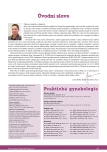Antichlamydial antibodies occurrence in men and women.
Authors:
J. Mikulová 1; M. Huljaková 1; L. Čisláková 2; M. Halánová 2; R. Dankovčík 1; Z. Szövenyiová 3; A. Ostró 1; M. Mikulová 1,4
Authors‘ workplace:
II. gynekologicko‑pôrodnícka klinika LF UPJŠ a FN L. Pasteura, Košice
1; Ústav epidemiológie LF UPJŠ, Košice
2; AVILAB s. r. o. – NZZ Klinická mikrobiológia, Košice
3; Gyncentrum s. r. o., Košice
4
Published in:
Prakt Gyn 2009; 13(3): 164-166
Overview
Chlamydia trachomatis is the most frequently worldwide reported bacterial sexually transmitted pathogen at present. Approximately 80% of infections are asymptomatic. Therefore we examined primarily risk groups of population. The enzyme‑linked immunosorbent assay (ELISA) was used. 3 462 blood samples were examined (2 506 from women and 956 from men). In the group of women the patients with clinical signs of chlamydial infection, women before delivery, and infertile women were examined. The women before abortion were examined as a control group. IgG antichlamydial antibodies were detected in 289 women (11.4%); IgA antichlamydial antibodies were found in 125 out of 2 506 women blood sera examined (4.9%). In both cases, the highest positivity was observed in the group of women between 20 to 29 years of age. In the group of men, the 4.3% positivity to presence of IgA antichlamydial antibodies and 11.8% positivity to presence of IgG antichlamydial antibodies were detected (tab. 3) [10].
Key words:
Chlamydia trachomatis – ELISA – IgA – IgG – prevalence
Sources
1. Binder T et al. Chlamýdiové infekcie v gravidite – možnosti diagnostiky a terapie. Čas Lék Čes 1993; 132: 19–22.
2. Kazár J, Lokša V, Osuský P. Chlamýdiové nákazy u ľudí. Bratislava: Veda 1992.
3. Mašata J, Řezáčová J, Sodja I et al. Význam průkazu přítomnosti antichlamydiových protilátek u sterilních žen – srovnání MIF a ELISA. Čes Gynek 2000; 65(5): 327–333.
4. Mašata J, Drazdaková M, Hrubá D et al. Prevalence of genital chlamydial infections among young females in Prague. Proceedings Fifth meeting of the European society for Chlamydia Research. 2004 September 1–4; Budapest, Hungary.
5. Medková Z, Kalousek I, Jarčuška P. Chlamydiové infekce. Praha: Triton 2001.
6. Norman J. Epidemiology of female genital Chlamydia trachomatis infection. Best Pract Res Clin Obstet Gynecol 2002; 16(6): 775–787.
7. Sodja I. Serological survey of antibodies against Chlamydiae. Zprávy CEM 1998; 7 (Suppl 1): 34–36.
8. Šemberová J, Manthey A, Ulčová-Gallová Z et al. Určení antichlamydiových protilátek v nestandardních biologických tekutinách u žen s poruchami plodnosti. Čes Gynek 2004; 69(3): 210–214.
9. Rogstad KE. Contact tracing and counsseling. Chapter 6 in International Handbook of Chlamydia by Moss TR. Doncaster UK 2001: 63–70.
10. Roubalová K, Janečková L. Doporučené metody pro diagnostiku Chlamydia trachomatis. Zprávy CEM 2005; 14(12): 510–514.
Labels
Paediatric gynaecology Gynaecology and obstetrics Reproduction medicineArticle was published in
Practical Gynecology

2009 Issue 3
Most read in this issue
- Lichen sclerosus.
- Malignant tumors of vulva
- Screening of disturbances of thyroid gland during pregnancy and postpartum
- Forensic aspects of assisted reproduction within the legislation context of the Czech and Slovak Republics.
